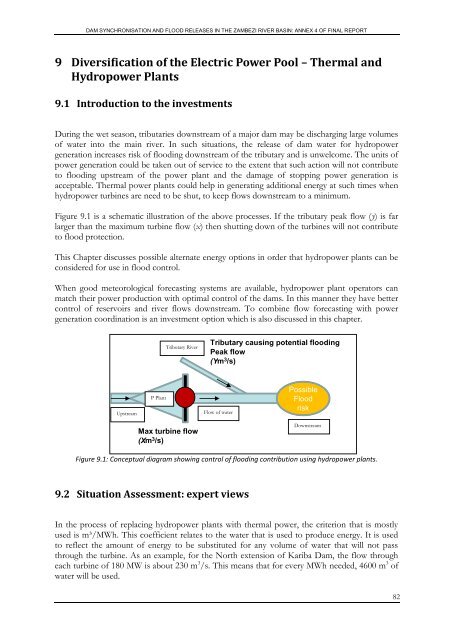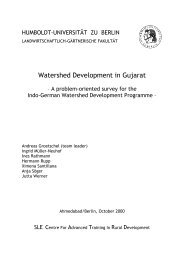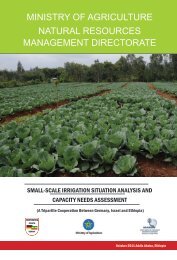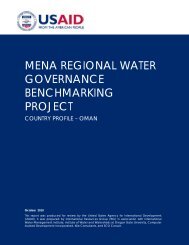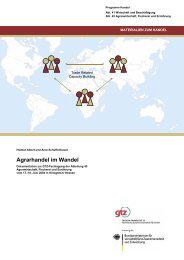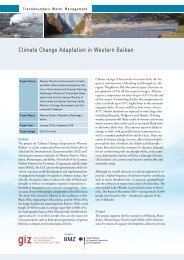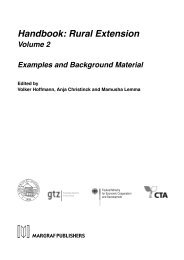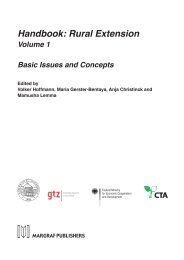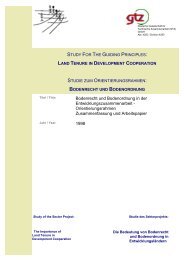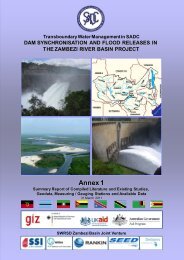Dam Synchronisation and Flood Releases - agriwaterpedia.info
Dam Synchronisation and Flood Releases - agriwaterpedia.info
Dam Synchronisation and Flood Releases - agriwaterpedia.info
You also want an ePaper? Increase the reach of your titles
YUMPU automatically turns print PDFs into web optimized ePapers that Google loves.
DAM SYNCHRONISATION AND FLOOD RELEASES IN THE ZAMBEZI RIVER BASIN: ANNEX 4 OF FINAL REPORT<br />
9 Diversification of the Electric Power Pool – Thermal <strong>and</strong><br />
Hydropower Plants<br />
9.1 Introduction to the investments<br />
During the wet season, tributaries downstream of a major dam may be discharging large volumes<br />
of water into the main river. In such situations, the release of dam water for hydropower<br />
generation increases risk of flooding downstream of the tributary <strong>and</strong> is unwelcome. The units of<br />
power generation could be taken out of service to the extent that such action will not contribute<br />
to flooding upstream of the power plant <strong>and</strong> the damage of stopping power generation is<br />
acceptable. Thermal power plants could help in generating additional energy at such times when<br />
hydropower turbines are need to be shut, to keep flows downstream to a minimum.<br />
Figure 9.1 is a schematic illustration of the above processes. If the tributary peak flow (y) is far<br />
larger than the maximum turbine flow (x) then shutting down of the turbines will not contribute<br />
to flood protection.<br />
This Chapter discusses possible alternate energy options in order that hydropower plants can be<br />
considered for use in flood control.<br />
When good meteorological forecasting systems are available, hydropower plant operators can<br />
match their power production with optimal control of the dams. In this manner they have better<br />
control of reservoirs <strong>and</strong> river flows downstream. To combine flow forecasting with power<br />
generation coordination is an investment option which is also discussed in this chapter.<br />
Tributary River<br />
Tributary causing potential flooding<br />
Peak flow<br />
(Y m 3 /s)<br />
Upstream<br />
P Plant<br />
Flow of water<br />
Possible<br />
<strong>Flood</strong><br />
risk<br />
Max turbine flow<br />
(X m 3 /s)<br />
Downstream<br />
Figure 9.1: Conceptual diagram showing control of flooding contribution using hydropower plants.<br />
9.2 Situation Assessment: expert views<br />
In the process of replacing hydropower plants with thermal power, the criterion that is mostly<br />
used is m³/MWh. This coefficient relates to the water that is used to produce energy. It is used<br />
to reflect the amount of energy to be substituted for any volume of water that will not pass<br />
through the turbine. As an example, for the North extension of Kariba <strong>Dam</strong>, the flow through<br />
each turbine of 180 MW is about 230 m 3 /s. This means that for every MWh needed, 4600 m 3 of<br />
water will be used.<br />
82


